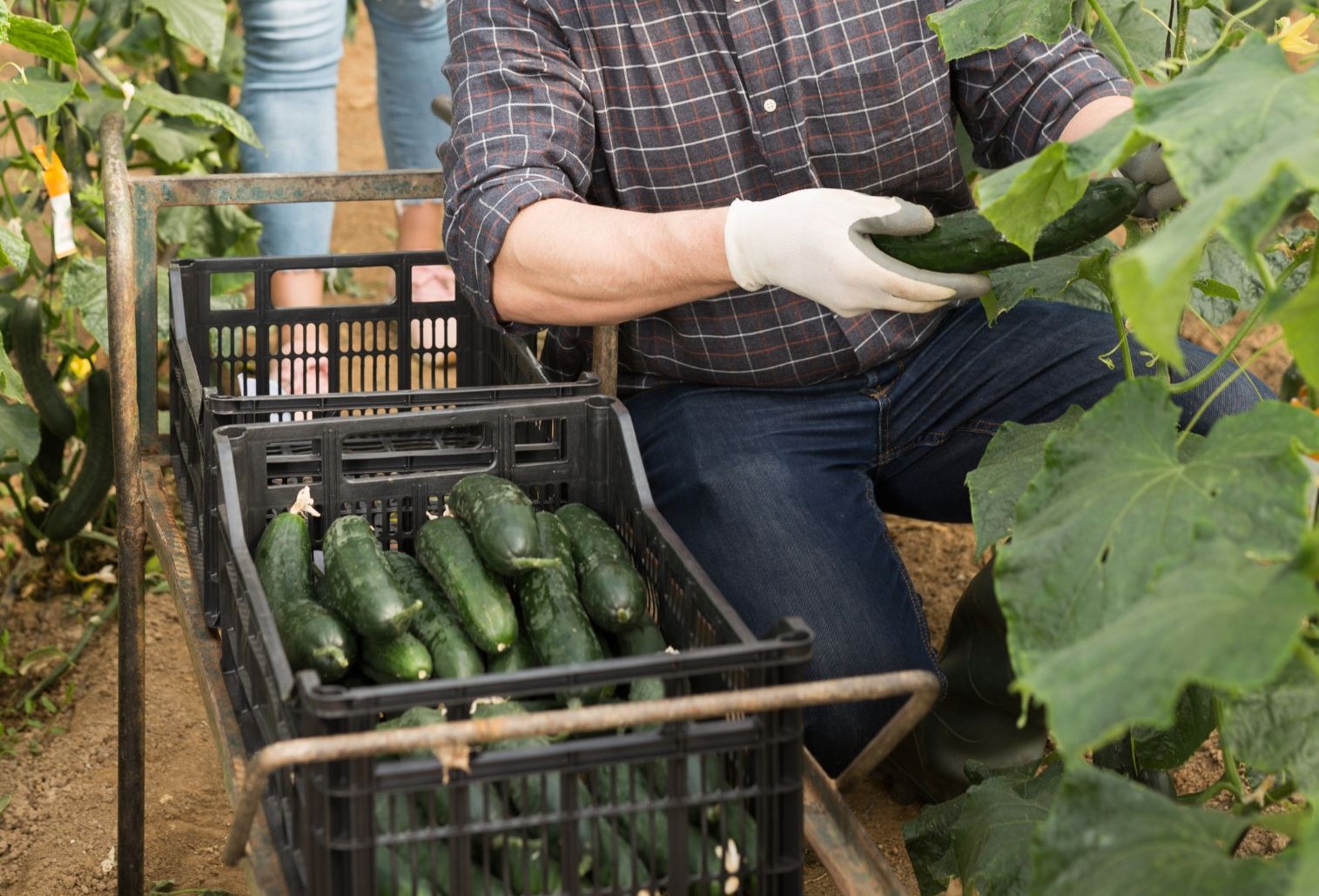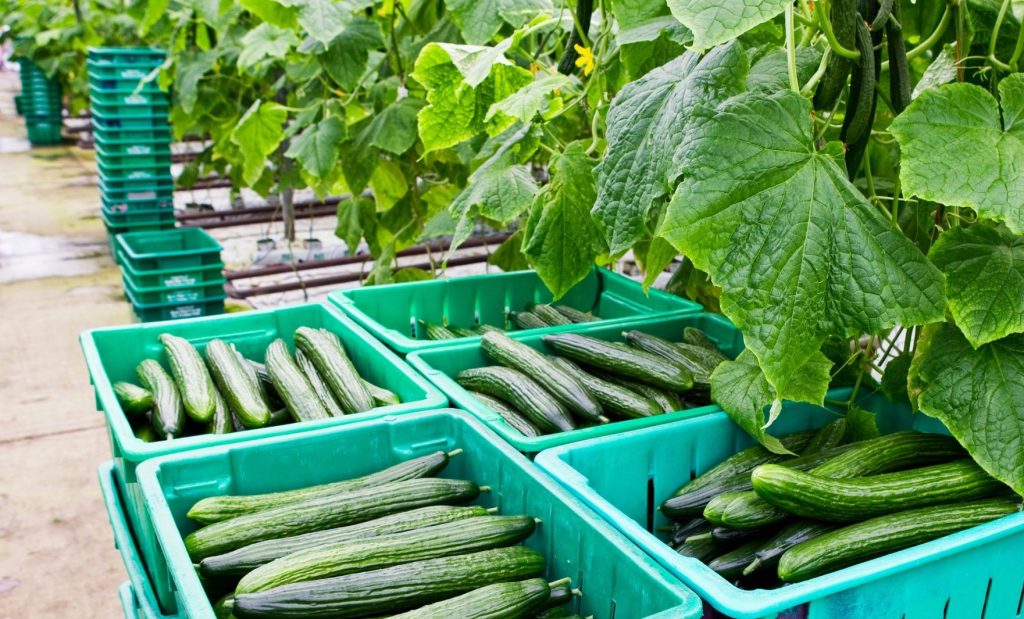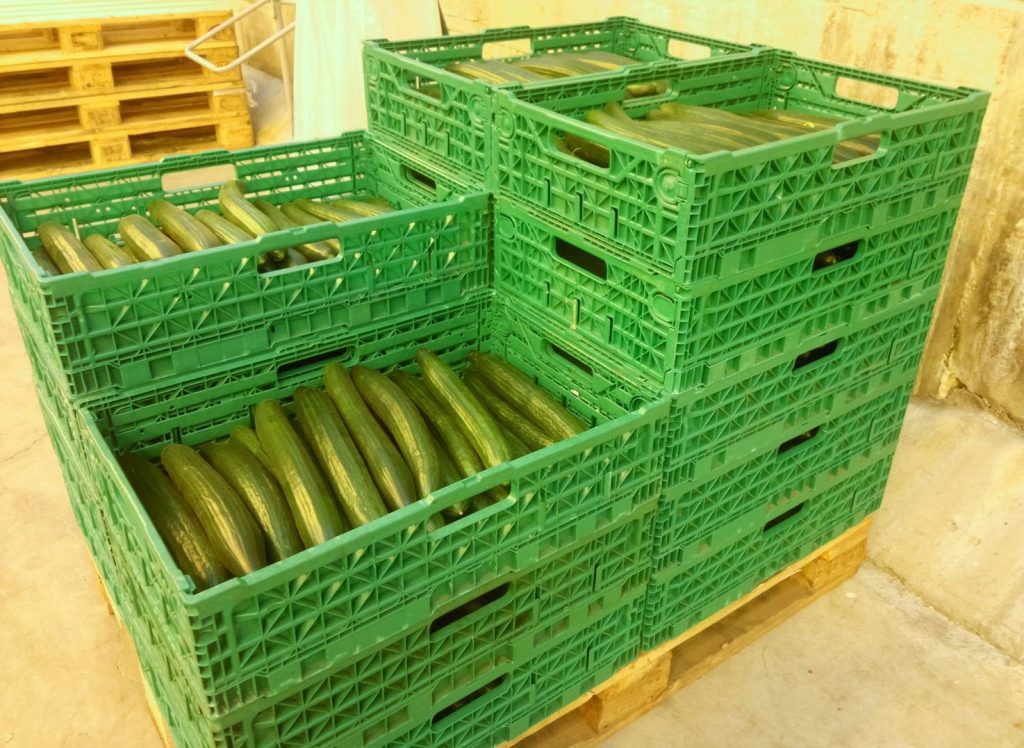Cucumber Yield, Harvest, and Storage

This post is also available in:
This post is also available in:
![]() Español (Spanish)
Español (Spanish) ![]() Français (French)
Français (French) ![]() Deutsch (German)
Deutsch (German) ![]() हिन्दी (Hindi)
हिन्दी (Hindi) ![]() Ελληνικά (Greek)
Ελληνικά (Greek)
Cucumber yield
As happens in every crop, cucumber yields depend on various factors. For example, some of these include variety selection, cultivation conditions and practices, time and duration of cultivation, and growers’ experience. (1).
For these reasons, the total final yield of the crop may vary significantly. Generally, a single cucumber plant can produce 9-11 kg (20-25 lb) of fruit. Some references mention that cucumber yield in is open-fields could be around 8-10 tons per hectare (3-3.6 t/acre) for a 90 days cucumber (for salad-slicing) (5). However, based on many references, the average yield for slicing cucumber in open fields is around 20-40 tons per hectare (7-15 t/acre) (1,6,9).
Pickling cucumbers can yield 9-27 tons per hectare (3-10 t/acre) (4,6). When a farmer grows high-yielding cucumber varieties in controlled environments, like glasshouses, with optimum conditions, support, and higher plant densities, the final yield could reach 80 to even 300 tons per hectare (29-110 t/acre) (10).
Cucumbers Harvesting Time and Quality Market Requirements
Generally, cucumbers are harvested manually, while in large operations, cucumbers can also be collected mechanically. The maturation and harvesting date may vary. Some hybrids with very small life cycles can be harvested 36-40 days after planting, some at 89-90 days, but most cucumber varieties are harvested in 50-60 days (7).
Cucumbers are generally harvested when they have reached the desirable size (depending on the variety and the market requirements), and the fruits are uniform. When cucumbers are harvested before seeds mature, they are marketed as seedless. It’s recommended to harvest cucumber before yellowing appears at the blossom end because, at that point, they become bitter and soft (3). For English-type cucumbers, a commercially accepted length is 12-14 inches (30-36 cm), while for slicing cucumbers, the proposed length is 7.5-8.5 inches (19-22 cm). Another interesting and useful information is that frequent harvests keep the plants productive (2).
Before harvesting, the grower has to scout the field and check for unmarketable fruits. These must be pulled from the plants and disked into the soil after harvesting. Cucumber must be harvested continuously in multiple “hands”-sessions (2-3 times per week). The harvested period can last around 12 weeks.

Cucumbers storage conditions and packaging – Post-harvest handling of cucumbers
Storage conditions affect the quality of the final product. It is essential to remove the harvested fruits from the field and the heat soon after harvest. To avoid the field’s heat, cucumbers are chilled as quickly as possible by hydro cooling with chilled water and forced-air cooling. In cases where such cooling methods cannot be applied, wetting with cold water can also be used to reduce respiration heat in bulk containers. All fruits are washed and graded based on size and general quality. Salad or sliced cucumbers are usually waxed to improve the appearance and shelf life of the product.
Cucumbers are stored in rooms with 10-13 °C (50-55 °F) temperature and 85-95% relative humidity (1,7). Cucumbers can be stored in such conditions for 10-20 days (7,8). Lower storage temperatures should be avoided since cucumber is sensitive, and problems of pitting and color change may be observed. (1). Shippers will have to know that cucumbers are susceptible when exposed to ethylene gas, which is used to ripen green tomatoes. As a result, we must avoid putting cucumbers next to vegetables that emit ethylene gases as they ripen (tomatoes, apples, etc.) (2).
Cucumbers are usually packed in crates or cartons of 12-14 kg (25-30 lb) and 23-25 kg (50-55 lb). Understanding the way cucumbers are grown, treated, harvested, and stored is not only useful for the farmers but also for the regulators that inspect the fields.
References
- https://www.aua.gr/
- https://www.wifss.ucdavis.edu/wp-content/uploads/2016/10/Cucumbers_PDF.pdf
- https://s3.wp.wsu.edu/uploads/sites/2071/2014/04/Growing-Cucumbers-FS096E.pdf
- https://www.gov.nl.ca/ffa/files/agrifoods-plants-pdf-cucumbers.pdf
- https://agritech.tnau.ac.in/horticulture/horti_vegetables_cucumber.html
- https://www.ontario.ca/page/cucumber-production
- https://extension.okstate.edu/fact-sheets/cucumber-production.html
- https://www.gov.nl.ca/ffa/files/agrifoods-plants-pdf-cucumbers.pdf
- https://www.researchgate.net/
- https://horticulture.oregonstate.edu/
Further reading
Cucumber History, Plant Information, Interesting facts, and Nutritional Value
How to grow cucumber for profit – Commercial cucumber cultivation
Principles for selecting the best Cucumber Variety
Cucumber Soil preparation, Soil, and Climate requirements, and Seeding requirements
Cucumber Irrigation – Water Requirements and Methods
Cucumber Fertilization Requirements and Methods
Weed Management in Cucumber Farming
Cucumber Yield, Harvest, and Storage








































































